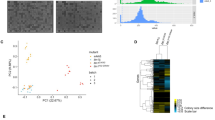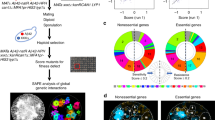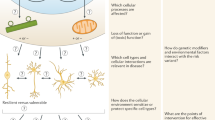Abstract
In ageing populations, neurodegenerative diseases increase in prevalence, exacting an enormous toll on individuals and their communities. Multiple complementary experimental approaches are needed to elucidate the mechanisms underlying these complex diseases and to develop novel therapeutics. Here, we describe why the budding yeast Saccharomyces cerevisiae has a unique role in the neurodegeneration armamentarium. As the best-understood and most readily analysed eukaryotic organism, S. cerevisiae is delivering mechanistic insights into cell-autonomous mechanisms of neurodegeneration at an interactome-wide scale.
This is a preview of subscription content, access via your institution
Access options
Subscribe to this journal
Receive 12 print issues and online access
$189.00 per year
only $15.75 per issue
Buy this article
- Purchase on Springer Link
- Instant access to full article PDF
Prices may be subject to local taxes which are calculated during checkout


Similar content being viewed by others
References
Smith, M. G. & Snyder, M. Yeast as a model for human disease. Curr. Protoc. Hum. Genet. Ch. 15, Unit 15.6 (2006).
Brandis, K. A. et al. α-Synuclein fission yeast model: concentration-dependent aggregation without plasma membrane localization or toxicity. J. Mol. Neurosci. 28, 179–191 (2006).
Codlin, S. & Mole, S. E. S. pombe btn1, the orthologue of the Batten disease gene CLN3, is required for vacuole protein sorting of Cpy1p and Golgi exit of Vps10p. J. Cell Sci. 122, 1163–1173 (2009).
Botstein, D., Chervitz, S. A. & Cherry, J. M. Yeast as a model organism. Science 277, 1259–1260 (1997).
Bassett, D. E., Boguski, M. S. & Hieter, P. Yeast genes and human disease. Nature 379, 589–590 (1996).
Foury, F. Human genetic diseases: a cross-talk between man and yeast. Gene 195, 1–10 (1997).
Lindquist, S., Krobitsch, S., Li, L. & Sondheimer, N. Investigating protein conformation-based inheritance and disease in yeast. Phil. Trans. R. Soc. Lond. B 356, 169–176 (2001).
Tessier, P. & Lindquist, S. Unraveling infectious structures, strain variants and species barriers for the yeast prion [PSI+]. Nature Struct. Mol. Biol. 16, 598–605 (2009).
Knott, A. B., Perkins, G., Schwarzenbacher, R. & Bossy-Wetzel, E. Mitochondrial fragmentation in neurodegeneration. Nature Rev. Neurosci. 9, 505–518 (2008).
Malhotra, V. & Emr, S. D. Rothman and Schekman SNAREd by Lasker for trafficking. Cell 111, 1–3 (2002).
Littleton, J. T. & Bellen, H. J. Synaptotagmin controls and modulates synaptic-vesicle fusion in a Ca2+-dependent manner. Trends Neurosci. 18, 177–183 (1995).
Cooper, A. A. et al. α-Synuclein blocks ER–Golgi traffic and Rab1 rescues neuron loss in Parkinson's models. Science 313, 324–328 (2006).
Lin, W. & Popko, B. Endoplasmic reticulum stress in disorders of myelinating cells. Nature Neurosci. 12, 379–385 (2009).
Scheper, W. & Hoozemans, J. J. Endoplasmic reticulum protein quality control in neurodegenerative disease: the good, the bad and the therapy. Curr. Med. Chem. 16, 615–626 (2009).
Herrup, K. & Yang, Y. Cell cycle regulation in the postmitotic neuron: oxymoron or new biology? Nature Rev. Neurosci. 8, 368–378 (2007).
Jin, C. & Reed, J. C. Yeast and apoptosis. Nature Rev. Mol. Cell Biol. 3, 453–459 (2002).
Cheng, W. C., Leach, K. M. & Hardwick, J. M. Mitochondrial death pathways in yeast and mammalian cells. Biochim. Biophys. Acta 1783, 1272–1279 (2008).
Khoury, C. & Greenwood, M. The pleiotropic effects of heterologous Bax expression in yeast. Biochim. Biophys. Acta 1783, 1449–1465 (2008).
Nakatogawa, H., Suzuki, K., Kamada, Y. & Ohsumi, Y. Dynamics and diversity in autophagy mechanisms: lessons from yeast. Nature Rev. Mol. Cell Biol. 10, 458–467 (2009).
Levine, B. & Kroemer, G. Autophagy in the pathogenesis of disease. Cell 132, 27–42 (2008).
Botstein, D. & Fink, G. R. Yeast: an experimental organism for modern biology. Science 240, 1439–1443 (1988).
Sherman, F. Getting started with yeast. Methods Enzymol. 350, 3–41 (2002).
van Anken, E. & Braakman, I. Endoplasmic reticulum stress and the making of a professional secretory cell. Crit. Rev. Biochem. Mol. Biol. 40, 269–283 (2005).
Knight, S., Kim, R., Pain, D. & Dancis, A. The yeast connection to Friedreich ataxia. Am. J. Hum. Genet. 64, 365–371 (1999).
Orr, H. T. & Zoghbi, H. Y. Trinucleotide repeat disorders. Annu. Rev. Neurosci. 30, 575–621 (2007).
Davies, S. W. et al. Formation of neuronal intranuclear inclusions underlies the neurological dysfunction in mice transgenic for the HD mutation. Cell 90, 537–548 (1997).
Hughes, R. E. et al. Altered transcription in yeast expressing expanded polyglutamine. Proc. Natl Acad. Sci. USA 98, 13201–13206 (2001).
Krobitsch, S. & Lindquist, S. Aggregation of huntingtin in yeast varies with the length of the polyglutamine expansion and the expression of chaperone proteins. Proc. Natl Acad. Sci. USA 97, 1589–1594 (2000).
Meriin, A. B. et al. Huntington toxicity in yeast model depends on polyglutamine aggregation mediated by a prion-like protein Rnq1. J. Cell Biol. 157, 997–1004 (2002).
Muchowski, P. J. et al. Hsp70 and Hsp40 chaperones can inhibit self-assembly of polyglutamine proteins into amyloid-like fibrils. Proc. Natl Acad. Sci. USA 97, 7841–7846 (2000).
Giorgini, F., Guidetti, P., Nguyen, Q., Bennett, S. C. & Muchowski, P. J. A genomic screen in yeast implicates kynurenine 3-monooxygenase as a therapeutic target for Huntington disease. Nature Genet. 37, 526–531 (2005).
Sokolov, S., Pozniakovsky, A., Bocharova, N., Knorre, D. & Severin, F. Expression of an expanded polyglutamine domain in yeast causes death with apoptotic markers. Biochim. Biophys. Acta 1757, 660–666 (2006).
Duennwald, M. L. & Lindquist, S. Impaired ERAD and ER stress are early and specific events in polyglutamine toxicity. Genes Dev. 22, 3308–3319 (2008).
Chen, Q., Thorpe, J. & Keller, J. N. α-Synuclein alters proteasome function, protein synthesis, and stationary phase viability. J. Biol. Chem. 280, 30009–30017 (2005).
Dixon, C., Mathias, N., Zweig, R. M., Davis, D. A. & Gross, D. S. α-Synuclein targets the plasma membrane via the secretory pathway and induces toxicity in yeast. Genetics 170, 47–59 (2005).
Flower, T. R., Chesnokova, L. S., Froelich, C. A., Dixon, C. & Witt, S. N. Heat shock prevents α-synuclein-induced apoptosis in a yeast model of Parkinson's disease. J. Mol. Biol. 351, 1081–1100 (2005).
Outeiro, T. F. & Lindquist, S. Yeast cells provide insight into α-synuclein biology and pathobiology. Science 302, 1772–1775 (2003).
Sharma, N. et al. α-Synuclein budding yeast model: toxicity enhanced by impaired proteasome and oxidative stress. J. Mol. Neurosci. 28, 161–178 (2006).
Winderickx, J. et al. Protein folding diseases and neurodegeneration: lessons learned from yeast. Biochim. Biophys. Acta 1783, 1381–1395 (2008).
Su, L. J. et al. Compounds from an unbiased chemical screen reverse both ER-to-Golgi trafficking defects and mitochondrial dysfunction in Parkinson's disease models. Dis. Model Mech. 3, 194–208 (2010).
Kritzer, J. A. et al. Rapid selection of cyclic peptides that reduce α-synuclein toxicity in yeast and animal models. Nature Chem. Biol. 5, 655–663 (2009).
Chopra, V. et al. A small-molecule therapeutic lead for Huntington's disease: preclinical pharmacology and efficacy of C2-8 in the R6/2 transgenic mouse. Proc. Natl Acad. Sci. USA 104, 16685–16689 (2007).
Schaffar, G. et al. Cellular toxicity of polyglutamine expansion proteins: mechanism of transcription factor deactivation. Mol. Cell 15, 95–105 (2004).
Duennwald, M. L., Jagadish, S., Giorgini, F., Muchowski, P. J. & Lindquist, S. A network of protein interactions determines polyglutamine toxicity. Proc. Natl Acad. Sci. USA 103, 11051–11056 (2006).
Duennwald, M. L., Jagadish, S., Muchowski, P. J. & Lindquist, S. Flanking sequences profoundly alter polyglutamine toxicity in yeast. Proc. Natl Acad. Sci. USA 103, 11045–11050 (2006).
Gitler, A. D. et al. α-Synuclein is part of a diverse and highly conserved interaction network that includes PARK9 and manganese toxicity. Nature Genet. 41, 308–315 (2009).
Jankovic, J. Searching for a relationship between manganese and welding and Parkinson's disease. Neurology 64, 2021–2028 (2005).
Ramirez, A. et al. Hereditary parkinsonism with dementia is caused by mutations in ATP13A2, encoding a lysosomal type 5 P-type ATPase. Nature Genet. 38, 1184–1191 (2006).
Schmidt, K., Wolfe, D. M., Stiller, B. & Pearce, D. A. Cd2+, Mn2+, Ni2+ and Se2+ toxicity to Saccharomyces cerevisiae lacking YPK9p the orthologue of human ATP13A2. Biochem. Biophys. Res. Commun. 383, 198–202 (2009).
Yeger-Lotem, E. et al. Bridging high-throughput genetic and transcriptional data reveals cellular responses to α-synuclein toxicity. Nature Genet. 41, 316–323 (2009).
Wahner, A. D., Bronstein, J. M., Bordelon, Y. M. & Ritz, B. Statin use and the risk of Parkinson disease. Neurology 70, 1418–1422 (2008).
Jones, G. M. et al. A systematic library for comprehensive overexpression screens in Saccharomyces cerevisiae. Nature Methods 5, 239–241 (2008).
DeRisi, J. L., Iyer, V. R. & Brown, P. O. Exploring the metabolic and genetic control of gene expression on a genomic scale. Science 278, 680–686 (1997).
Alberti, S., Gitler, A. D. & Lindquist, S. A suite of Gateway® cloning vectors for high-throughput genetic analysis in Saccharomyces cerevisiae. Yeast 24, 913–919 (2007).
Ejsing, C. S. et al. Global analysis of the yeast lipidome by quantitative shotgun mass spectrometry. Proc. Natl Acad. Sci. USA 106, 2136–2141 (2009).
Gaspar, M. L. et al. The emergence of yeast lipidomics. Biochim. Biophys. Acta 1771, 241–254 (2007).
Hoon, S., St Onge, R. P., Giaever, G. & Nislow, C. Yeast chemical genomics and drug discovery: an update. Trends Pharmacol. Sci. 29, 499–504 (2008).
Parsons, A. B. et al. Exploring the mode-of-action of bioactive compounds by chemical-genetic profiling in yeast. Cell 126, 611–625 (2006).
Hillenmeyer, M. E. et al. The chemical genomic portrait of yeast: uncovering a phenotype for all genes. Science 320, 362–365 (2008).
Outeiro, T. F. & Giorgini, F. Yeast as a drug discovery platform in Huntington's and Parkinson's diseases. Biotechnol. J. 1, 258–269 (2006).
Willingham, S., Outeiro, T. F., DeVit, M. J., Lindquist, S. L. & Muchowski, P. J. Yeast genes that enhance the toxicity of a mutant huntingtin fragment or α-synuclein. Science 302, 1769–1772 (2003).
Zhang, X. et al. A potent small molecule inhibits polyglutamine aggregation in Huntington's disease neurons and suppresses neurodegeneration in vivo. Proc. Natl Acad. Sci. USA 102, 892–897 (2005).
Ehrnhoefer, D. E. et al. Green tea (-)-epigallocatechin-gallate modulates early events in huntingtin misfolding and reduces toxicity in Huntington's disease models. Hum. Mol. Genet. 15, 2743–2751 (2006).
Marsh, J. L. & Thompson, L. M. Drosophila in the study of neurodegenerative disease. Neuron 52, 169–178 (2006).
Tam, S., Geller, R., Spiess, C. & Frydman, J. The chaperonin TRiC controls polyglutamine aggregation and toxicity through subunit-specific interactions. Nature Cell Biol. 8, 1155–1162 (2006).
Vacher, C., Garcia-Oroz, L. & Rubinsztein, D. C. Overexpression of yeast hsp104 reduces polyglutamine aggregation and prolongs survival of a transgenic mouse model of Huntington's disease. Hum. Mol. Genet. 14, 3425–3433 (2005).
Carnemolla, A. et al. RRS1 is involved in endoplasmic reticulum stress response in Huntington's disease. J. Biol. Chem. 284, 18167–18173 (2009).
Sas, K., Robotka, H., Toldi, J. & Vécsei, L. Mitochondria, metabolic disturbances, oxidative stress and the kynurenine system, with focus on neurodegenerative disorders. J. Neurol. Sci. 257, 221–239 (2007).
Arrasate, M., Mitra, S., Schweitzer, E. S., Segal, M. R. & Finkbeiner, S. Inclusion body formation reduces levels of mutant huntingtin and the risk of neuronal death. Nature 431, 805–810 (2004).
Treusch, S., Cyr, D. M. & Lindquist, S. Amyloid deposits: protection against toxic protein species? Cell Cycle 8, 1668–1674 (2009).
Gitler, A. D. et al. The Parkinson's disease protein α-synuclein disrupts cellular Rab homeostasis. Proc. Natl Acad. Sci. USA 105, 145–150 (2008).
Soper, J. H. et al. α-Synuclein-induced aggregation of cytoplasmic vesicles in Saccharomyces cerevisiae. Mol. Biol. Cell 19, 1093–1103 (2008).
Flower, T. R. et al. YGR198w (YPP1) targets A30P α-synuclein to the vacuole for degradation. J. Cell Biol. 177, 1091–104 (2007).
Griffioen, G. et al. A yeast-based model of α-synucleinopathy identifies compounds with therapeutic potential. Biochim. Biophys. Acta 1762, 312–318 (2006).
Larsen, K. E. et al. α-Synuclein overexpression in PC12 and chromaffin cells impairs catecholamine release by interfering with a late step in exocytosis. J. Neurosci. 26, 11915–11922 (2006).
Nemani, V. M. et al. Increased expression of α-synuclein reduces neurotransmitter release by inhibiting synaptic vesicle reclustering after endocytosis. Neuron 65, 66–79 (2010).
Cabin, D. E. et al. Synaptic vesicle depletion correlates with attenuated synaptic responses to prolonged repetitive stimulation in mice lacking α-synuclein. J. Neurosci. 22, 8797–8807 (2002).
Pearce, D. A., Ferea, T., Nosel, S. A., Das, B. & Sherman, F. Action of BTN1, the yeast orthologue of the gene mutated in Batten disease. Nature Genet. 22, 55–58 (1999).
Zhang, S. et al. Ncr1p, the yeast ortholog of mammalian Niemann Pick C1 protein, is dispensable for endocytic transport. Traffic 5, 1017–1030 (2004).
Moore, J. K., Sept, D. & Cooper, J. A. Neurodegeneration mutations in dynactin impair dynein-dependent nuclear migration. Proc. Natl Acad. Sci. USA 106, 5147–5152 (2009).
Pearce, D. A. Hereditary spastic paraplegia: mitochondrial metalloproteases of yeast. Hum. Genet. 104, 443–448 (1999).
Shani, N. & Valle, D. A Saccharomyces cerevisiae homolog of the human adrenoleukodystrophy transporter is a heterodimer of two half ATP-binding cassette transporters. Proc. Natl Acad. Sci. USA 93, 11901–11906 (1996).
Middendorp, O., Lüthi, U., Hausch, F. & Barberis, A. Searching for the most effective screening system to identify cell-active inhibitors of β-secretase. Biol. Chem. 385, 481–485 (2004).
Bagriantsev, S. & Liebman, S. Modulation of Αβ42 low-n oligomerization using a novel yeast reporter system. BMC Biol. 4, 32 (2006).
von der Haar, T., Jossé, L., Wright, P., Zenthon, J. & Tuite, M. F. Development of a novel yeast cell-based system for studying the aggregation of Alzheimer's disease-associated αβ peptides in vivo. Neurodegener. Dis. 4, 136–147 (2007).
Caine, J. et al. Alzheimer's Aβ fused to green fluorescent protein induces growth stress and a heat shock response. FEMS Yeast Res. 7, 1230–1236 (2007).
Bharadwaj, P., Waddington, L., Varghese, J. & Macreadie, I. G. A new method to measure cellular toxicity of non-fibrillar and fibrillar Alzheimer's Aβ using yeast. J. Alzheimers Dis. 13, 147–150 (2008).
Johnson, B. S., McCaffery, J. M., Lindquist, S. & Gitler, A. D. A yeast TDP-43 proteinopathy model: exploring the molecular determinants of TDP-43 aggregation and cellular toxicity. Proc. Natl Acad. Sci. USA 105, 6439–6444 (2008).
Apodaca, J., Kim, I. & Rao, H. Cellular tolerance of prion protein PrP in yeast involves proteolysis and the unfolded protein response. Biochem. Biophys. Res. Commun. 347, 319–326 (2006).
Ma, J. & Lindquist, S. De novo generation of a PrPSc-like conformation in living cells. Nature Cell Biol. 1, 358–361 (1999).
Tank, E. M., Harris, D. A., Desai, A. A. & True, H. L. Prion protein repeat expansion results in increased aggregation and reveals phenotypic variability. Mol. Cell. Biol. 27, 5445–5455 (2007).
Yang, W., Yang, H. & Tien, P. In vitro self-propagation of recombinant PrPSc-like conformation generated in the yeast cytoplasm. FEBS Lett. 580, 4231–4235 (2006).
Acknowledgements
We thank members of the Lindquist laboratory for their insightful comments on the manuscript, and particularly E. Nabieva for her assistance in the preparation of Table 2. S.L. is an Investigator at the Howard Hughes Medical Institute (HHMI). This work was supported by an HHMI Collaborative Innovation Award, US National Institutes of Health Udall program grant NS038372, and the Whitehead Institute Regenerative Biology Initiative.
Author information
Authors and Affiliations
Corresponding author
Ethics declarations
Competing interests
Susan Lindquist is a co-founder of, a former member of the Board of Directors of and has received consulting fees from FoldRx Pharmaceuticals, a company that investigates drugs for treating protein-folding diseases. She is an inventor of patents and patent applications that have been licensed to FoldRx. She is also a member of the Board of Directors of Johnson & Johnson.
Related links
Rights and permissions
About this article
Cite this article
Khurana, V., Lindquist, S. Modelling neurodegeneration in Saccharomyces cerevisiae: why cook with baker's yeast?. Nat Rev Neurosci 11, 436–449 (2010). https://doi.org/10.1038/nrn2809
Published:
Issue Date:
DOI: https://doi.org/10.1038/nrn2809



